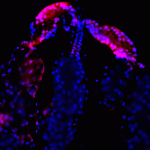Link to Pubmed [PMID] – 33520739
Link to DOI – 61434210.3389/fcimb.2020.614342
Front Cell Infect Microbiol 2020 ; 10(): 614342
The piRNA pathway is a specialized small RNA interference that in mosquitoes is mechanistically distant from analogous biology in the Drosophila model. Current genetic engineering methods, such as targeted genome manipulation, have a high potential to tease out the functional complexity of this intricate molecular pathway. However, progress in utilizing these methods in arthropod vectors has been geared mostly toward the development of new vector control strategies rather than to study cellular functions. Herein we propose that genetic engineering methods will be essential to uncover the full functionality of PIWI/piRNA biology in mosquitoes and that extending the applications of genetic engineering on other aspects of mosquito biology will grant access to a much larger pool of knowledge in disease vectors that is just out of reach. We discuss motivations for and impediments to expanding the utility of genetic engineering to study the underlying biology and disease transmission and describe specific areas where efforts can be placed to achieve the full potential for genetic engineering in basic biology in mosquito vectors. Such efforts will generate a refreshed intellectual source of novel approaches to disease control and strong support for the effective use of approaches currently in development.

